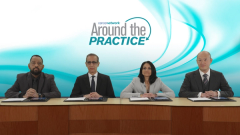
Clinical Pearls on Treating GVHD
Experts on graft-vs-host disease offer clinical insights for clinicians treating patients with GVHD.
Episodes in this series

Transcript:
Preet M. Chaudhary, MD, PhD: Finally, what are the clinical pearls you would like to share with the clinicians treating GVHD [graft-vs-host disease]? What are the main things you have learned from your experience?
Eric Leon Tam, MD: I would say that chronic GVHD in particular is a very clinical diagnosis. It’s very tough to do, and you have to always be on your toes because it can pop up at any time. In Hector’s case, it popped up a year after the transplant when he was doing well, and we thought he was in the clear and he was off of all medications practically. There are some routine studies you probably should do to check in on these patients.
For example, for patients who receive high levels of radiation, you should do routine 1-year post-transplant PFTs [pulmonary function tests] to look for subclinical disease. It is something that always needs to be on the transplanter’s radar, and whomever they’re following up with afterward also needs to be aware of this. They might be admitted for pneumonia but it’s not pneumonia, it could be chronic GVHD.
Preet M. Chaudhary, MD, PhD: Lakshmi, is there anything else you would like to add?
Lakshmi Savitala-Damerla, PA-C: Yes, as Dr Tam said, educating the patient about what to be on the lookout for, monitoring them, and preventive maintenance. For example, for some of our patients who get radiation, FTBI [fractionated total body irradiation], as part of their conditioning regimen, we typically do PFTs at 6 months and 1 year. I would even venture to say if there have been some changes, maybe doing it every year until there is stability in their lung function, I think goes a long way. Also, let patients know that once you’re diagnosed with chronic GVHD, we are able to target and treat, but there’s always a risk of it coming back. It’s not a permanent cure where you’re one and done, so you always are on the lookout for chronic graft-vs-host disease.
Preet M. Chaudhary, MD, PhD: It’s also very important to diagnose it early as we already talked about. I think if you catch it early and suppress it, you have a better chance of.
Lakshmi Savitala-Damerla, PA-C: Theoutcomes are better.
Preet M. Chaudhary, MD, PhD: Theoutcome is better. Then also in my experience, what I observed is, as you already mentioned, GVHD may be involving the skin. You can easily diagnose skin GVHD because it’s visible. You can also diagnose liver GVHD by running the LFTs [liver function tests]. But that may be a sign of GVHD involving other organs like the lung, which are much more difficult to diagnose, and they are much more at capacity. My personal philosophy is to use those as a marker of ongoing GVHD of the organ, and take it seriously and suppress it, because GVHD if left uncontrolled and untreated can have very devastating consequences for the patient outcome.
Lakshmi Savitala-Damerla, PA-C: I think one of the things is also as we treat, we get focused on the medications, and you alluded to this earlier too, making sure we are also adding appropriate antimicrobial preventive things. These patients if they are progressing, they’re really not going to die of GVHD, it’s going to be because of the infection that’s out of control. So keeping an eye on it, always keeping your eyes and ears open for secondary infections, is going to be key to maintaining these patients.
Preet M. Chaudhary, MD, PhD: In that context, I think the treatment landscape for antimicrobial prophylaxis has also changed. Compared to many years ago, we have better agents to control fungal infections, and better agents to control CMV [cytomegalovirus]. So I think the concern in the past that if we suppress GVHD we are putting patients at much higher risk of infection, may be mitigated to some extent now because we can fight the GVHD and at the same time fight the infection much better. I think that’s a very important point because I have seen people in the past withdraw the GVHD prophylaxis too early because they were concerned about the infection. The infection risk is real, but the GVHD risk is real as well, so now luckily we have agents to fight on both fronts at the same time.
Transcript edited for clarity.
Newsletter
Stay up to date on recent advances in the multidisciplinary approach to cancer.
























































































